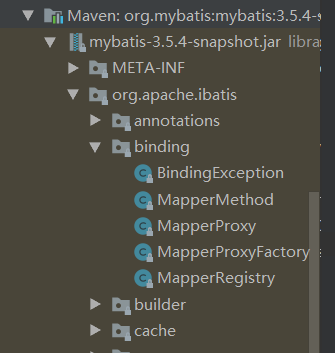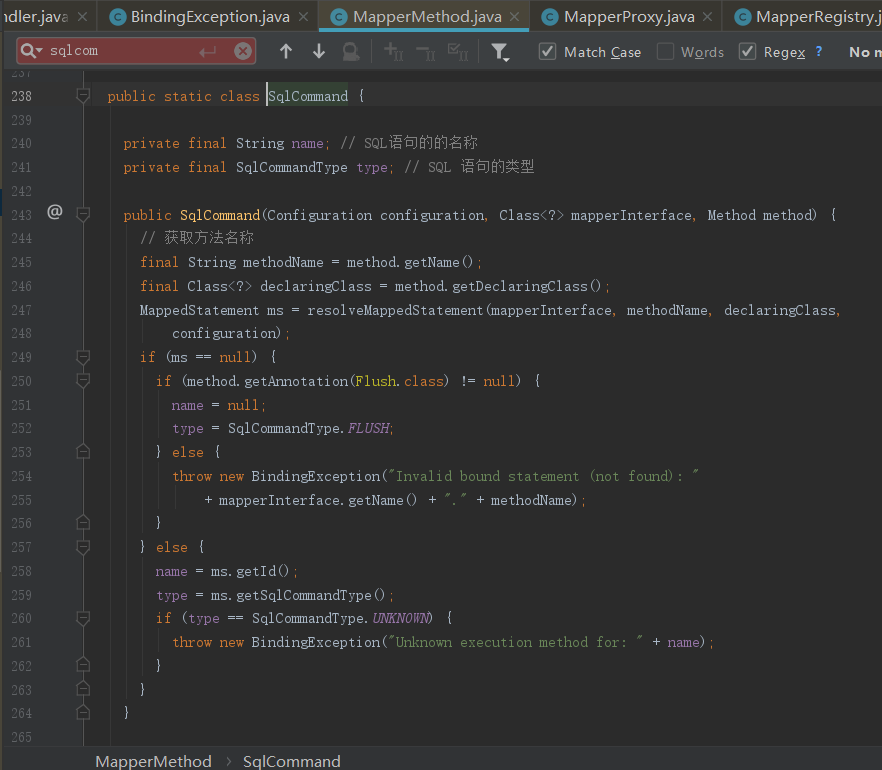mybaits源码分析--binding模块(五)
一、binding模块
接下来我们看看在org.apache.ibatis.binding包下提供的Binding模块 ,binding其实在执行sqlSession.getMapper(UserMapper.class);获取接口代理的对象时有用到;

发现这个包里面提供的工具比较少,就几个,先来分别了解下他们的作用,然后在串联起来。
1.1 MapperRegistry
这显然是一个注册中心,这个注册中是用来保存MapperProxyFactory对象的,所以这个注册器中提供的功能肯定是围绕MapperProxyFactory的添加和获取操作,来看看具体的代码逻辑
成员变量:
private final Configuration config;
// 记录 Mapper 接口和 MapperProxyFactory 之间的关系
private final Map<Class<?>, MapperProxyFactory<?>> knownMappers = new HashMap<>();
addMapper方法
public <T> void addMapper(Class<T> type) {
if (type.isInterface()) { // 检测 type 是否为接口
if (hasMapper(type)) { // 检测是否已经加装过该接口
throw new BindingException("Type " + type + " is already known to the MapperRegistry.");
}
boolean loadCompleted = false;
try {
// !Map<Class<?>, MapperProxyFactory<?>> 存放的是接口类型,和对应的工厂类的关系
knownMappers.put(type, new MapperProxyFactory<>(type));
// It's important that the type is added before the parser is run
// otherwise the binding may automatically be attempted by the
// mapper parser. If the type is already known, it won't try.
// 注册了接口之后,根据接口,开始解析所有方法上的注解,例如 @Select >>
MapperAnnotationBuilder parser = new MapperAnnotationBuilder(config, type);
parser.parse();
loadCompleted = true;
} finally {
if (!loadCompleted) {
knownMappers.remove(type);
}
}
}
}
getMapper方法
/**
* 获取Mapper接口对应的代理对象
*/
public <T> T getMapper(Class<T> type, SqlSession sqlSession) {
// 获取Mapper接口对应的 MapperProxyFactory 对象
final MapperProxyFactory<T> mapperProxyFactory = (MapperProxyFactory<T>) knownMappers.get(type);
if (mapperProxyFactory == null) {
throw new BindingException("Type " + type + " is not known to the MapperRegistry.");
}
try {
return mapperProxyFactory.newInstance(sqlSession);
} catch (Exception e) {
throw new BindingException("Error getting mapper instance. Cause: " + e, e);
}
}
通过这个方法本质上获取的就是Mapper接口的代理对象。
1.2 MapperProxyFactory
MapperProxyFactory是一个工厂对象,专门负责创建MapperProxy对象。其中核心字段的含义和功能如下:
/**
* 负责创建 MapperProxy 对象
* @author Lasse Voss
*/
public class MapperProxyFactory<T> { /**
* MapperProxyFactory 可以创建 mapperInterface 接口的代理对象
* 创建的代理对象要实现的接口
*/
private final Class<T> mapperInterface;
// 缓存
private final Map<Method, MapperMethodInvoker> methodCache = new ConcurrentHashMap<>(); public MapperProxyFactory(Class<T> mapperInterface) {
this.mapperInterface = mapperInterface;
} public Class<T> getMapperInterface() {
return mapperInterface;
} public Map<Method, MapperMethodInvoker> getMethodCache() {
return methodCache;
} @SuppressWarnings("unchecked")
/**
* 创建实现了 mapperInterface 接口的代理对象
*/
protected T newInstance(MapperProxy<T> mapperProxy) {
// 1:类加载器:2:被代理类实现的接口、3:实现了 InvocationHandler 的触发管理类
return (T) Proxy.newProxyInstance(mapperInterface.getClassLoader(), new Class[] { mapperInterface }, mapperProxy);
} public T newInstance(SqlSession sqlSession) {
final MapperProxy<T> mapperProxy = new MapperProxy<>(sqlSession, mapperInterface, methodCache);
return newInstance(mapperProxy);
} }
1.3 MapperProxy
通过MapperProxyFactory创建的MapperProxy是Mapper接口的代理对象,实现了InvocationHandler接口,通过前面讲解的动态代理模式,那么这部分的内容就很简单了。
/**
* Mapper 代理对象
* @author
* @author
*/
public class MapperProxy<T> implements InvocationHandler, Serializable { private static final long serialVersionUID = -4724728412955527868L;
private static final int ALLOWED_MODES = MethodHandles.Lookup.PRIVATE | MethodHandles.Lookup.PROTECTED
| MethodHandles.Lookup.PACKAGE | MethodHandles.Lookup.PUBLIC;
private static final Constructor<Lookup> lookupConstructor;
private static final Method privateLookupInMethod;
private final SqlSession sqlSession; // 记录关联的 SqlSession对象
private final Class<T> mapperInterface; // Mapper接口对应的Class对象
// 用于缓存MapperMethod对象,key是Mapper接口方法对应的Method对象,value是对应的MapperMethod对象。‘
// MapperMethod对象会完成参数转换以及SQL语句的执行
// 注意:MapperMethod中并不会记录任何状态信息,可以在多线程间共享
private final Map<Method, MapperMethodInvoker> methodCache; public MapperProxy(SqlSession sqlSession, Class<T> mapperInterface, Map<Method, MapperMethodInvoker> methodCache) {
this.sqlSession = sqlSession;
this.mapperInterface = mapperInterface;
this.methodCache = methodCache;
} static {
Method privateLookupIn;
try {
privateLookupIn = MethodHandles.class.getMethod("privateLookupIn", Class.class, MethodHandles.Lookup.class);
} catch (NoSuchMethodException e) {
privateLookupIn = null;
}
privateLookupInMethod = privateLookupIn; Constructor<Lookup> lookup = null;
if (privateLookupInMethod == null) {
// JDK 1.8
try {
lookup = MethodHandles.Lookup.class.getDeclaredConstructor(Class.class, int.class);
lookup.setAccessible(true);
} catch (NoSuchMethodException e) {
throw new IllegalStateException(
"There is neither 'privateLookupIn(Class, Lookup)' nor 'Lookup(Class, int)' method in java.lang.invoke.MethodHandles.",
e);
} catch (Exception e) {
lookup = null;
}
}
lookupConstructor = lookup;
} @Override
public Object invoke(Object proxy, Method method, Object[] args) throws Throwable {
try {
// toString hashCode equals getClass等方法,无需走到执行SQL的流程
if (Object.class.equals(method.getDeclaringClass())) {
return method.invoke(this, args);
} else {
// 提升获取 mapperMethod 的效率,到 MapperMethodInvoker(内部接口) 的 invoke
// 普通方法会走到 PlainMethodInvoker(内部类) 的 invoke
return cachedInvoker(method).invoke(proxy, method, args, sqlSession);
}
} catch (Throwable t) {
throw ExceptionUtil.unwrapThrowable(t);
}
} private MapperMethodInvoker cachedInvoker(Method method) throws Throwable {
try {
// Java8 中 Map 的方法,根据 key 获取值,如果值是 null,则把后面Object 的值赋给 key
// 如果获取不到,就创建
// 获取的是 MapperMethodInvoker(接口) 对象,只有一个invoke方法
// 根据method 去methodCache中获取 如果返回空 则用第二个参数填充
return methodCache.computeIfAbsent(method, m -> {
if (m.isDefault()) {
// 接口的默认方法(Java8),只要实现接口都会继承接口的默认方法,例如 List.sort()
try {
if (privateLookupInMethod == null) {
return new DefaultMethodInvoker(getMethodHandleJava8(method));
} else {
return new DefaultMethodInvoker(getMethodHandleJava9(method));
}
} catch (IllegalAccessException | InstantiationException | InvocationTargetException
| NoSuchMethodException e) {
throw new RuntimeException(e);
}
} else {
// 创建了一个 MapperMethod
return new PlainMethodInvoker(new MapperMethod(mapperInterface, method, sqlSession.getConfiguration()));
}
});
} catch (RuntimeException re) {
Throwable cause = re.getCause();
throw cause == null ? re : cause;
}
} private MethodHandle getMethodHandleJava9(Method method)
throws NoSuchMethodException, IllegalAccessException, InvocationTargetException {
final Class<?> declaringClass = method.getDeclaringClass();
return ((Lookup) privateLookupInMethod.invoke(null, declaringClass, MethodHandles.lookup())).findSpecial(
declaringClass, method.getName(), MethodType.methodType(method.getReturnType(), method.getParameterTypes()),
declaringClass);
} private MethodHandle getMethodHandleJava8(Method method)
throws IllegalAccessException, InstantiationException, InvocationTargetException {
final Class<?> declaringClass = method.getDeclaringClass();
return lookupConstructor.newInstance(declaringClass, ALLOWED_MODES).unreflectSpecial(method, declaringClass);
} interface MapperMethodInvoker {
Object invoke(Object proxy, Method method, Object[] args, SqlSession sqlSession) throws Throwable;
} private static class PlainMethodInvoker implements MapperMethodInvoker {
private final MapperMethod mapperMethod; public PlainMethodInvoker(MapperMethod mapperMethod) {
super();
this.mapperMethod = mapperMethod;
} @Override
public Object invoke(Object proxy, Method method, Object[] args, SqlSession sqlSession) throws Throwable {
// SQL执行的真正起点
return mapperMethod.execute(sqlSession, args);
}
} private static class DefaultMethodInvoker implements MapperMethodInvoker {
private final MethodHandle methodHandle; public DefaultMethodInvoker(MethodHandle methodHandle) {
super();
this.methodHandle = methodHandle;
} @Override
public Object invoke(Object proxy, Method method, Object[] args, SqlSession sqlSession) throws Throwable {
return methodHandle.bindTo(proxy).invokeWithArguments(args);
}
}
}
1.4 MapperMethod
MapperMethod中封装了Mapper接口中对应方法的信息,以及SQL语句的信息,可以把MapperMethod看成是配置文件中定义的SQL语句和Mapper接口的桥梁。
属性和构造方法
// statement id (例如:com.gupaoedu.mapper.BlogMapper.selectBlogById) 和 SQL 类型
private final SqlCommand command;
// 方法签名,主要是返回值的类型
private final MethodSignature method; public MapperMethod(Class<?> mapperInterface, Method method, Configuration config) {
this.command = new SqlCommand(config, mapperInterface, method);
this.method = new MethodSignature(config, mapperInterface, method);
}
1.4.1 SqlCommand
SqlCommand是MapperMethod中定义的内部类,记录了SQL语句名称以及对应的类型(UNKNOWN,INSERT,UPDATE,DELETE,SELECT,FLUSH)
1.4.2 MethodSignature
MethodSignature也是MapperMethod的内部类,在其中封装了Mapper接口中定义的方法相关信息。
private final boolean returnsMany; // 判断返回是否为 Collection类型或者数组类型
private final boolean returnsMap; // 返回值是否为 Map类型
private final boolean returnsVoid; // 返回值类型是否为 void
private final boolean returnsCursor; // 返回值类型是否为 Cursor 类型
private final boolean returnsOptional; // 返回值类型是否为 Optional 类型
private final Class<?> returnType; // 返回值类型
private final String mapKey; // 如果返回值类型为 Map 则 mapKey 记录了作为 key的 列名
private final Integer resultHandlerIndex; // 用来标记该方法参数列表中 ResultHandler 类型参数的位置
private final Integer rowBoundsIndex; // 用来标记该方法参数列表中 rowBounds 类型参数的位置
private final ParamNameResolver paramNameResolver; // 该方法对应的 ParamNameResolver 对象
构造方法中完成了相关信息分初始化操作
/**
* 方法签名
* @param configuration
* @param mapperInterface
* @param method
*/
public MethodSignature(Configuration configuration, Class<?> mapperInterface, Method method) {
// 获取接口方法的返回类型
Type resolvedReturnType = TypeParameterResolver.resolveReturnType(method, mapperInterface);
if (resolvedReturnType instanceof Class<?>) {
this.returnType = (Class<?>) resolvedReturnType;
} else if (resolvedReturnType instanceof ParameterizedType) {
this.returnType = (Class<?>) ((ParameterizedType) resolvedReturnType).getRawType();
} else {
this.returnType = method.getReturnType();
}
this.returnsVoid = void.class.equals(this.returnType);
this.returnsMany = configuration.getObjectFactory().isCollection(this.returnType) || this.returnType.isArray();
this.returnsCursor = Cursor.class.equals(this.returnType);
this.returnsOptional = Optional.class.equals(this.returnType);
this.mapKey = getMapKey(method);
this.returnsMap = this.mapKey != null;
// getUniqueParamIndex 查找指定类型的参数在 参数列表中的位置
this.rowBoundsIndex = getUniqueParamIndex(method, RowBounds.class);
this.resultHandlerIndex = getUniqueParamIndex(method, ResultHandler.class);
this.paramNameResolver = new ParamNameResolver(configuration, method);
}
getUniqueParamIndex的主要作用是 查找指定类型的参数在参数列表中的位置
/**
* 查找指定类型的参数在参数列表中的位置
* @param method
* @param paramType
* @return
*/
private Integer getUniqueParamIndex(Method method, Class<?> paramType) {
Integer index = null;
// 获取对应方法的参数列表
final Class<?>[] argTypes = method.getParameterTypes();
// 遍历
for (int i = 0; i < argTypes.length; i++) {
// 判断是否是需要查找的类型
if (paramType.isAssignableFrom(argTypes[i])) {
// 记录对应类型在参数列表中的位置
if (index == null) {
index = i;
} else {
// RowBounds 和 ResultHandler 类型的参数只能有一个,不能重复出现
throw new BindingException(method.getName() + " cannot have multiple " + paramType.getSimpleName() + " parameters");
}
}
}
return index;
}
1.4.3 execute方法
最后来看下再MapperMethod中最核心的方法execute方法,这个方法完成了数据库操作
public Object execute(SqlSession sqlSession, Object[] args) {
Object result;
switch (command.getType()) { // 根据SQL语句的类型调用SqlSession对应的方法
case INSERT: {
// 通过 ParamNameResolver 处理args[] 数组 将用户传入的实参和指定参数名称关联起来
Object param = method.convertArgsToSqlCommandParam(args);
// sqlSession.insert(command.getName(), param) 调用SqlSession的insert方法
// rowCountResult 方法会根据 method 字段中记录的方法的返回值类型对结果进行转换
result = rowCountResult(sqlSession.insert(command.getName(), param));
break;
}
case UPDATE: {
Object param = method.convertArgsToSqlCommandParam(args);
result = rowCountResult(sqlSession.update(command.getName(), param));
break;
}
case DELETE: {
Object param = method.convertArgsToSqlCommandParam(args);
result = rowCountResult(sqlSession.delete(command.getName(), param));
break;
}
case SELECT:
if (method.returnsVoid() && method.hasResultHandler()) {
// 返回值为空 且 ResultSet通过 ResultHandler处理的方法
executeWithResultHandler(sqlSession, args);
result = null;
} else if (method.returnsMany()) {
result = executeForMany(sqlSession, args);
} else if (method.returnsMap()) {
result = executeForMap(sqlSession, args);
} else if (method.returnsCursor()) {
result = executeForCursor(sqlSession, args);
} else {
// 返回值为 单一对象的方法
Object param = method.convertArgsToSqlCommandParam(args);
// 普通 select 语句的执行入口 >>
result = sqlSession.selectOne(command.getName(), param);
if (method.returnsOptional()
&& (result == null || !method.getReturnType().equals(result.getClass()))) {
result = Optional.ofNullable(result);
}
}
break;
case FLUSH:
result = sqlSession.flushStatements();
break;
default:
throw new BindingException("Unknown execution method for: " + command.getName());
}
if (result == null && method.getReturnType().isPrimitive() && !method.returnsVoid()) {
throw new BindingException("Mapper method '" + command.getName()
+ " attempted to return null from a method with a primitive return type (" + method.getReturnType() + ").");
}
return result;
}
在这个方法中所对应一些分支方法都还是比较简单的,看一下其实就懂,我就不想再往里跟了
1.4.4 核心流程串联
首先在映射文件加载解析的位置,XMLMapperBuilder.parse位置
public void parse() {
// 总体上做了两件事情,对于语句的注册和接口的注册
if (!configuration.isResourceLoaded(resource)) {
// 1、具体增删改查标签的解析。
// 一个标签一个MappedStatement。 >>
configurationElement(parser.evalNode("/mapper"));
configuration.addLoadedResource(resource);
// 2、把namespace(接口类型)和工厂类绑定起来,放到一个map。
// 一个namespace 一个 MapperProxyFactory >>
bindMapperForNamespace();
}
parsePendingResultMaps();
parsePendingCacheRefs();
parsePendingStatements();
}
在bindMapperForNamespace中会完成Mapper接口的注册并调用前面介绍过的addMapper方法然后就是在我们执行
// 4.通过SqlSession中提供的 API方法来操作数据库
UserMapper mapper = sqlSession.getMapper(UserMapper.class);
List<User> list = mapper.selectUserList();
这两行代码的内部逻辑,首先看下getMapper方法
public <T> T getMapper(Class<T> type) {
return configuration.getMapper(type, this);
}
public <T> T getMapper(Class<T> type, SqlSession sqlSession) {
// mapperRegistry中注册的有Mapper的相关信息 在解析映射文件时 调用过addMapper方法
return mapperRegistry.getMapper(type, sqlSession);
}
然后就是从MapperRegistry中获取对应的MapperProxyFactory对象。
/**
* 获取Mapper接口对应的代理对象
*/
public <T> T getMapper(Class<T> type, SqlSession sqlSession) {
// 获取Mapper接口对应的 MapperProxyFactory 对象
final MapperProxyFactory<T> mapperProxyFactory = (MapperProxyFactory<T>) knownMappers.get(type);
if (mapperProxyFactory == null) {
throw new BindingException("Type " + type + " is not known to the MapperRegistry.");
}
try {
return mapperProxyFactory.newInstance(sqlSession);
} catch (Exception e) {
throw new BindingException("Error getting mapper instance. Cause: " + e, e);
}
}
然后根据MapperProxyFactory对象获取Mapper接口对应的代理对象。
/**
* 创建实现了 mapperInterface 接口的代理对象
*/
protected T newInstance(MapperProxy<T> mapperProxy) {
// 1:类加载器:2:被代理类实现的接口、3:实现了 InvocationHandler 的触发管理类
return (T) Proxy.newProxyInstance(mapperInterface.getClassLoader(), new Class[] { mapperInterface }, mapperProxy);
} public T newInstance(SqlSession sqlSession) {
final MapperProxy<T> mapperProxy = new MapperProxy<>(sqlSession, mapperInterface, methodCache);
return newInstance(mapperProxy);
}
不清楚可以看前面画的时序图

然后我们再来看下调用代理对象中的方法执行的顺序
List<User> list = mapper.selectUserList();
会进入MapperProxy的Invoker方法中
@Override
public Object invoke(Object proxy, Method method, Object[] args) throws Throwable {
try {
// toString hashCode equals getClass等方法,无需走到执行SQL的流程
if (Object.class.equals(method.getDeclaringClass())) {
return method.invoke(this, args);
} else {
// 提升获取 mapperMethod 的效率,到 MapperMethodInvoker(内部接口) 的 invoke
// 普通方法会走到 PlainMethodInvoker(内部类) 的 invoke
return cachedInvoker(method).invoke(proxy, method, args, sqlSession);
}
} catch (Throwable t) {
throw ExceptionUtil.unwrapThrowable(t);
}
}
然后进入PlainMethodInvoker中的invoke方法
@Override
public Object invoke(Object proxy, Method method, Object[] args, SqlSession sqlSession) throws Throwable {
// SQL执行的真正起点
return mapperMethod.execute(sqlSession, args);
}
}
然后会进入到 MapperMethod的execute方法中
public Object execute(SqlSession sqlSession, Object[] args) {
Object result;
switch (command.getType()) { // 根据SQL语句的类型调用SqlSession对应的方法
case INSERT: {
// 通过 ParamNameResolver 处理args[] 数组 将用户传入的实参和指定参数名称关联起来
Object param = method.convertArgsToSqlCommandParam(args);
// sqlSession.insert(command.getName(), param) 调用SqlSession的insert方法
// rowCountResult 方法会根据 method 字段中记录的方法的返回值类型对结果进行转换
result = rowCountResult(sqlSession.insert(command.getName(), param));
break;
}
case UPDATE: {
Object param = method.convertArgsToSqlCommandParam(args);
result = rowCountResult(sqlSession.update(command.getName(), param));
break;
}
case DELETE: {
Object param = method.convertArgsToSqlCommandParam(args);
result = rowCountResult(sqlSession.delete(command.getName(), param));
break;
}
case SELECT:
if (method.returnsVoid() && method.hasResultHandler()) {
// 返回值为空 且 ResultSet通过 ResultHandler处理的方法
executeWithResultHandler(sqlSession, args);
result = null;
} else if (method.returnsMany()) {
result = executeForMany(sqlSession, args);
} else if (method.returnsMap()) {
result = executeForMap(sqlSession, args);
} else if (method.returnsCursor()) {
result = executeForCursor(sqlSession, args);
} else {
// 返回值为 单一对象的方法
Object param = method.convertArgsToSqlCommandParam(args);
// 普通 select 语句的执行入口 >>
result = sqlSession.selectOne(command.getName(), param);
if (method.returnsOptional()
&& (result == null || !method.getReturnType().equals(result.getClass()))) {
result = Optional.ofNullable(result);
}
}
break;
case FLUSH:
result = sqlSession.flushStatements();
break;
default:
throw new BindingException("Unknown execution method for: " + command.getName());
}
if (result == null && method.getReturnType().isPrimitive() && !method.returnsVoid()) {
throw new BindingException("Mapper method '" + command.getName()
+ " attempted to return null from a method with a primitive return type (" + method.getReturnType() + ").");
}
return result;
}
之后就会根据对应的SQL类型而调用SqlSession中对应的方法来执行操作
mybaits源码分析--binding模块(五)的更多相关文章
- mybaits源码分析--缓存模块(六)
一.缓存模块 MyBatis作为一个强大的持久层框架,缓存是其必不可少的功能之一,Mybatis中的缓存分为一级缓存和二级缓存.但本质上是一样的,都是使用Cache接口实现的.缓存位于 org.apa ...
- mybaits源码分析--日志模块(四)
一.日志模块 首先日志在我们开发过程中占据了一个非常重要的地位,是开发和运维管理之间的桥梁,在Java中的日志框架也非常多,Log4j,Log4j2,Apache Commons Log,java.u ...
- 手机自动化测试:appium源码分析之bootstrap五
手机自动化测试:appium源码分析之bootstrap五 poptest是国内唯一一家培养测试开发工程师的培训机构,以学员能胜任自动化测试,性能测试,测试工具开发等工作为目标.poptest测试 ...
- ABP源码分析四十五:ABP ZERO中的EntityFramework模块
AbpZeroDbContext:配置ABP.Zero中定义的entity的Dbset EntityFrameworkModelBuilderExtensions:给PrimitiveProperty ...
- mybaits源码分析(一)
一.源码下载 1.手动编译源码 为了方便在看源码的过程中能够方便的添加注释,可以从官网下载源码编译生成对应的Jar包,然后上传到本地maven仓库,再引用这个Jar. 首先需要编译打包parent项目 ...
- nginx源码分析之模块初始化
在nginx启动过程中,模块的初始化是整个启动过程中的重要部分,而且了解了模块初始化的过程对应后面具体分析各个模块会有事半功倍的效果.在我看来,分析源码来了解模块的初始化是最直接不过的了,所以下面主要 ...
- ABP源码分析二十五:EventBus
IEventData/EventData: 封装了EventData信息,触发event的源对象和时间 IEventBus/EventBus: 定义和实现了了一系列注册,注销和触发事件处理函数的方法. ...
- ABP源码分析三十五:ABP中动态WebAPI原理解析
动态WebAPI应该算是ABP中最Magic的功能之一了吧.开发人员无须定义继承自ApiController的类,只须重用Application Service中的类就可以对外提供WebAPI的功能, ...
- [Abp vNext 源码分析] - 2. 模块系统的变化
一.简要说明 本篇文章主要分析 Abp vNext 当中的模块系统,从类型构造层面上来看,Abp vNext 当中不再只是单纯的通过 AbpModuleManager 来管理其他的模块,它现在则是 I ...
随机推荐
- JMeter Gui – TestElement约定[转]
转自https://www.cnblogs.com/yigui/p/7615635.html 在编写任何JMeter组件时,必须注意某些特定的约定--如果JMeter环境中正确地运行JMeter组件, ...
- synchronized 优化手段之锁膨胀机制!
synchronized 在 JDK 1.5 之前性能是比较低的,在那时我们通常会选择使用 Lock 来替代 synchronized.然而这个情况在 JDK 1.6 时就发生了改变,JDK 1.6 ...
- Docker 安装与卸载
Docker卸载与安装 卸载旧的版本 卸载 yum -y remove docker-ce docker-cli-io containerd.io rm -rf var /var/lib/docker ...
- 小白的 Python 修炼手册:入门篇
Life is short, you need Python.(人生苦短,我用 Python.) --Bruce Eckel 前言 听说现在是全民 Python 的时代,虽然不知道事实如何,但学会 P ...
- CSS 即将支持嵌套,SASS/LESS 等预处理器已无用武之地?
最近,有一则非常振奋人心的消息,CSS 即将原生支持嵌套 -- Agenda+ to publish FPWD of Nesting,表示 CSS 嵌套规范即将进入规范的 FWPD 阶段. 目前对应的 ...
- Windows协议 Kerberos篇
认证流程 角色 功能 Domain Controller 也就是域控 Key Distribution Center 秘钥分发中心,简称KDC,默认安装在域控里,包括AS.AD和TGS. Accoun ...
- Crash course statistics
Crash course statistics 01什么是统计学 描述性统计(Descriptive statistics) 推理统计可以得出之外的,基于"样本"的推论统计学来估计 ...
- 01 CTF从0到。。。。
无意间在前段时间接触到了CTF,感觉很有意思,就参加了个单位的短期培训,并且参加了比赛,也是无意混进了决赛.感觉自己不会的还很多!SO,开始写博客开始刷题,自己很菜,不会C,不会Python,不会汇编 ...
- php本地文件包含 Writeup
目录 本地文件包含 LFI本地文件包含案例一 LFI本地文件包含案例二 本地文件包含简介 文件包含函数加载的参数没有经过过滤或者严格的定义,可以被用户控制,包含其他恶意文件,导致了执行了非预期的代码. ...
- Are You OK?主键、聚集索引、辅助索引
每张表都一定存在主键吗? 关于这个问题,各位小伙伴们不妨先自己想一想,再往下寻找答案. 首先公布结论:对于 InnoDB 存储引擎来说,每张表都一定有个主键(Primary Key)! 让人非常遗憾的 ...
